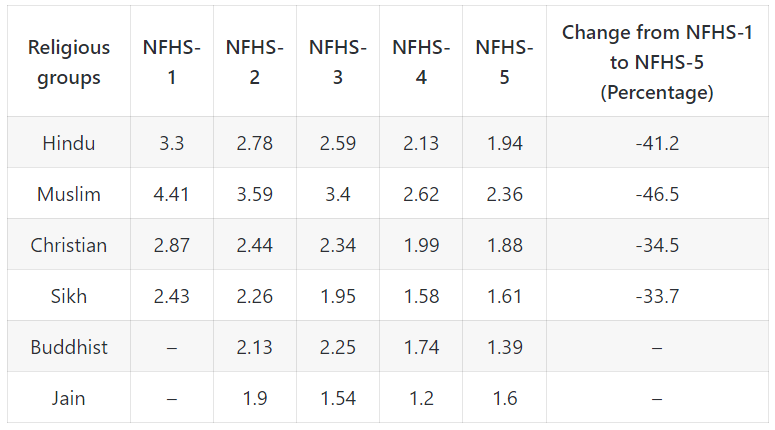Ishfaq-ul-Hassan
NEW DELHI–National Family Health Survey (NFHS-5)has busted the propaganda of Sangh Parivar against Muslims.
NFHS survey has revealed that the total fertility rate (TFR) among Muslims has dropped by 46.5 percent. It declined from 4.4 children per woman in 1992-92 to 2.3 children in 2019-20.
Over the five rounds of NFHS so far, the TFR among Hindus declined by 41.2 percent whereas, Christians and Sikhs saw TFR drop by about a third.
Currently, the TFR among Hindus is 1.94 whereas, among Christians and Sikhs, the rate is 1.88 and 1.61 respectively.

TFR of entire India has declined from 2.2 to 2.0 indicating the significant progress of population control measures.
There are only five states in India, which are above the replacement level of fertility of 2.1. These states are Bihar (2.98), Meghalaya (2.91), Uttar Pradesh (2.35), Jharkhand (2.26), and Manipur (2.17).
As per the survey, the median age at first birth among women aged 25-49 years is 21.2 years. The survey also revealed that seven percent of women aged 15-19 years have begun childbearing.
NHFS-5 revealed that institutional births have increased substantially from 79 percent to 89 percent in India. Even in rural areas around 87 percent of births are delivered in institutions and the same is 94 percent in urban areas.
Institutional births increased by a maximum of 27 percentage points in Arunachal Pradesh, followed by over 10 percentage points in Assam, Bihar, Meghalaya, Chhattisgarh, Nagaland, Manipur, Uttar Pradesh, and West Bengal. Over 91 percent of districts have more than 70 percent of births in the last 5 years that took place in health facilities.
The NFHS-5 survey work has been conducted in around 6.37 lakh sample households from 707 districts (as of March 2017) of the country from 28 States and eight UTs, covering 7,24,115 women and 1,01,839 men to provide dis-aggregated estimates up to district level.
The national report also provides data on socio-economic and other background characteristics; useful for policy formulation and effective program implementation.
“NFHS-5 provides information on important indicators which help track the progress of Sustainable Development Goals (SDGs) in the country. NFHS-4 (2015-16) estimates were used as baseline values for a large number of SDG indicators and NFHS- 5 will provide data for around 34 SDG indicators at various levels,’’ said an official statement.





